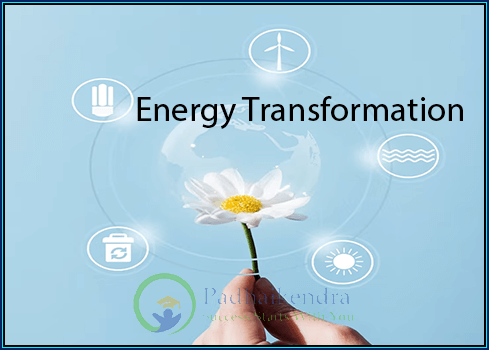The transformation of energy refers to the conversion of energy from one form to another. Energy exists in various forms, such as mechanical, thermal, chemical, electrical, and electromagnetic, and it can be changed or transferred between these different forms through physical or chemical processes.
Energy transformations are a fundamental concept in physics and play a crucial role in understanding the behavior and functioning of systems. Here are some common examples of energy transformations:
- Electrical energy to light energy: This happens in light bulbs, where electrical energy is transformed into light energy.
- Chemical energy to thermal energy: This happens in burning fuels such as natural gas, coal, or wood. The chemical energy stored in the fuel is transformed into thermal energy.
- Nuclear energy to electrical energy: This happens in nuclear power plants, where the energy released from nuclear reactions is transformed into electrical energy.
- Mechanical energy to electrical energy: This happens in generators, where mechanical energy is transformed into electrical energy.
- Solar energy to electrical energy: This happens in solar panels, where solar energy is transformed into electrical energy.
- Wind energy to electrical energy: This happens in wind turbines, where the energy from the wind is transformed into electrical energy.

- Thermal energy to mechanical energy: This happens in steam turbines, where the thermal energy from steam is transformed into mechanical energy.
- Electrical energy to Thermal energy: Electrical energy can be converted into thermal energy through devices like electric heaters or stoves. When an electric current passes through a resistive element, it encounters resistance, resulting in the generation of heat.
- Light energy to Electrical energy: Photovoltaic cells, commonly known as solar cells, transform light energy from the Sun into electrical energy. The cells absorb photons from sunlight, which excite electrons and create an electric potential difference, generating an electric current.
- Potential energy to Kinetic energy: When an object is lifted to a higher position against the force of gravity, potential energy is stored. As the object falls, this potential energy is converted into kinetic energy, the energy of motion. The higher the object is lifted, the greater the potential energy and the more kinetic energy it will have when falling.
Energy transformations follow the principle of conservation of energy (laws of thermodynamics), which states that energy cannot be created or destroyed, only transferred or converted from one form to another. The total amount of energy in a closed system remains constant, even though it can change from one form to another.
Understanding energy transformations is essential in various fields, including physics, engineering, and environmental science. By analyzing and optimizing energy transformations, we can improve the efficiency of devices and systems, reduce energy waste, and explore sustainable energy sources.
The transformation of energy involves the conversion of energy from one form to another. It is a fundamental concept in physics and is observed in various processes and systems. By studying energy transformations, we can better understand the behavior of energy and its applications in different fields.






